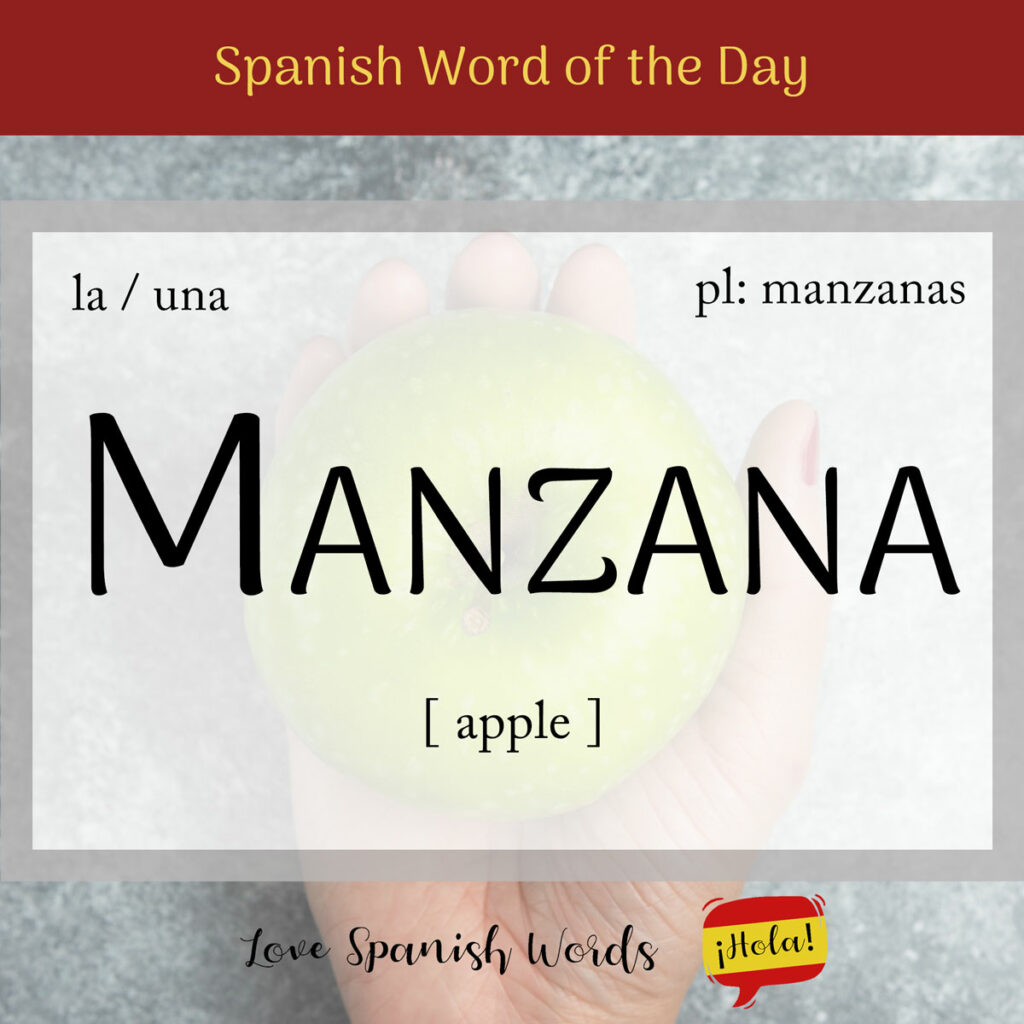The Spanish word for the fruit apple, manzana, is from an Iberian vulgar dialect word mattiana, which is a shortened form of the Vulgar Latin mālum matianum, a specific type of apple, “Apples of Matius.” Mattiana became mazana or maçana in Old Spanish.
Latin American pronunciation
European pronunciation

Manzana is a feminine noun, so it takes the following definite and indefinite articles:
- la manzana = the apple
- las manzanas = the apples
- una manzana = an apple
- unas manzanas = some apples
¿Cuánto cuesta un kilo de manzanas en tu país?
How much does a kilo of apples cost in your country?
Similar to English, there are various different types of apple in Spanish, things you can do with apples and also phrases that use the word apple. Let’s deal with a few of them below:
- manzana de mesa = eating apple
- manzana silvestre = crab apple
- pastel/tarta de manzana = apple pie
- compote/puré de manzana = apple sauce
- corazón de manzana = apple core
- manzana de Adán = Adam’s apple
- zumo/jugo de manzana = apple juice

¿zumo o jugo? – you may hear juice being referred to as either zumo or jugo depending on where you are.
As a rule of thumb:
In Spain, zumo is the juice of fruits and jugo is the liquid from anything juicy (but not to be served as a drink, juices from meat etc.) and is also used for other things like “juicy news” and so on.
In Latin America, everything is jugo be that juice from a fruit or any other kind of juice.
Me gusta tomar un jugo de manzana por la mañana.
I like to have an apple juice in the morning.
Me gusta tomar un zumo de manzana por la mañana.
I like to have an apple juice in the morning.

As well as being a delicious fruit, the word manzana in Spanish can be used for a block on a street or an urban space. The use of the word manzana in this context dates back to feudal times in Europe when a manso was the land that a feudal lord would give out to be worked. People would live on the land and work it for them as tenants. Collections of mansos were called mansanas and the peasant farmers who worked the mansos earned money and provided services for the lord as subjects.
So as society changed, the term mansana shifted over to manzana due to the similar sound of the s and z and mansana lost its meaning. Collections of houses became manzanas “city blocks.”

El supermercado está a dos manzanas de mi casa.
The supermarket is two blocks away from my house.
Finally the most common idiom using the word manzana is manzana de la discordia. Literally translated into English, this means apple of discord and is used to describe a bone of contention, the core or crux of an argument that could develop into something larger. The golden apple of discord originates back to Greek mythology.
Esa parece ser la manzana de la discordia.
This seems to be the bone of contention.
Interestingly in the Eixample district of Barcelona, there is a block (or manzana) nicknamed in Spanish La manzana de la discordia. It was so named (“block of discord”) because it features four different interpretations of Catalan Modernist architecture: Antoni Gaudí, Lluís Domènech I Montaner, Josep Puig I Cadafalch and Enric Sagnier were some of the most prestigious architects of the time and were all commissioned to work on the block.

Did you know that…?
New York City is often referred to as La Gran Manzana in Spanish, which literally translates to “The Big Apple.”

